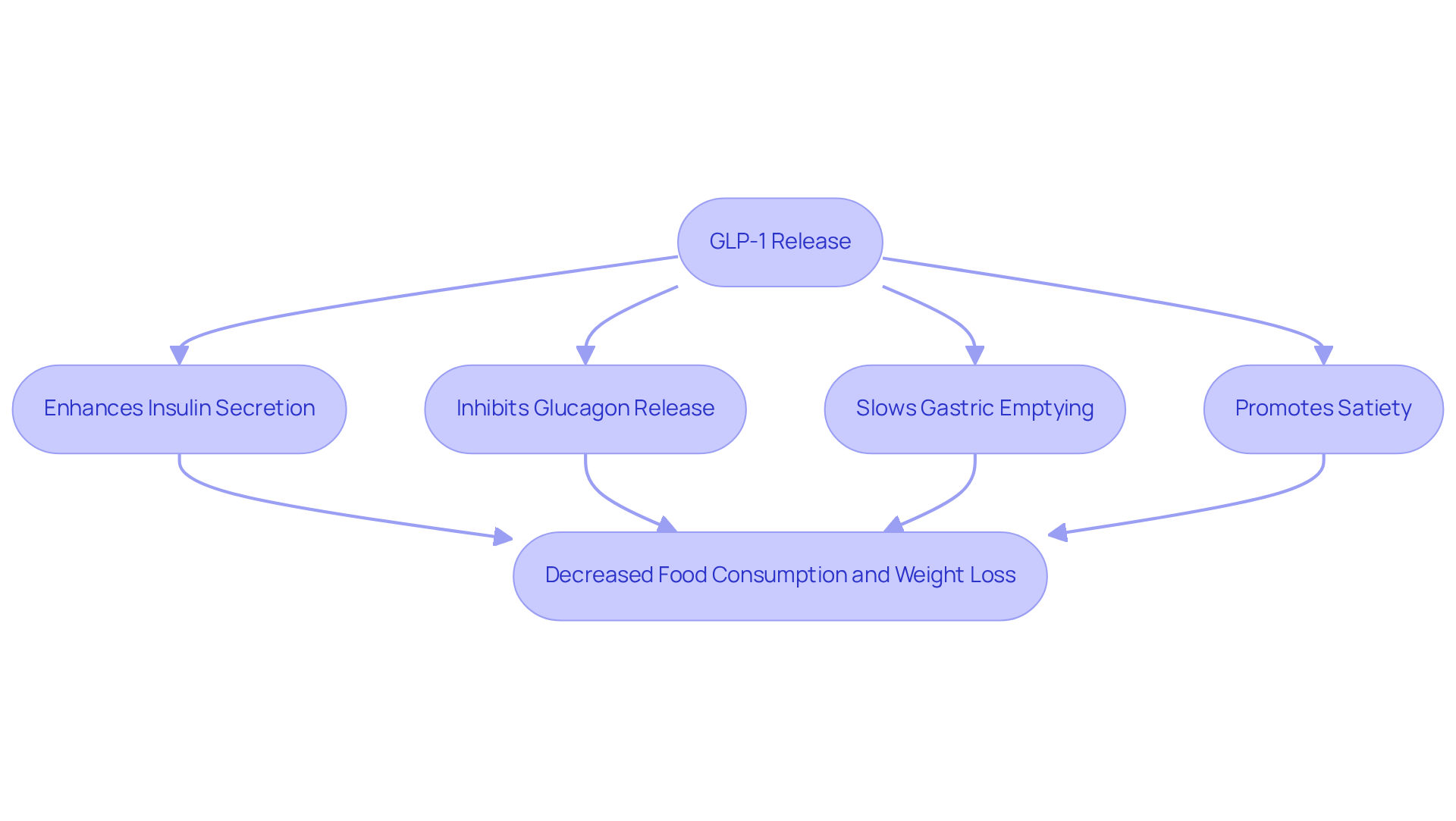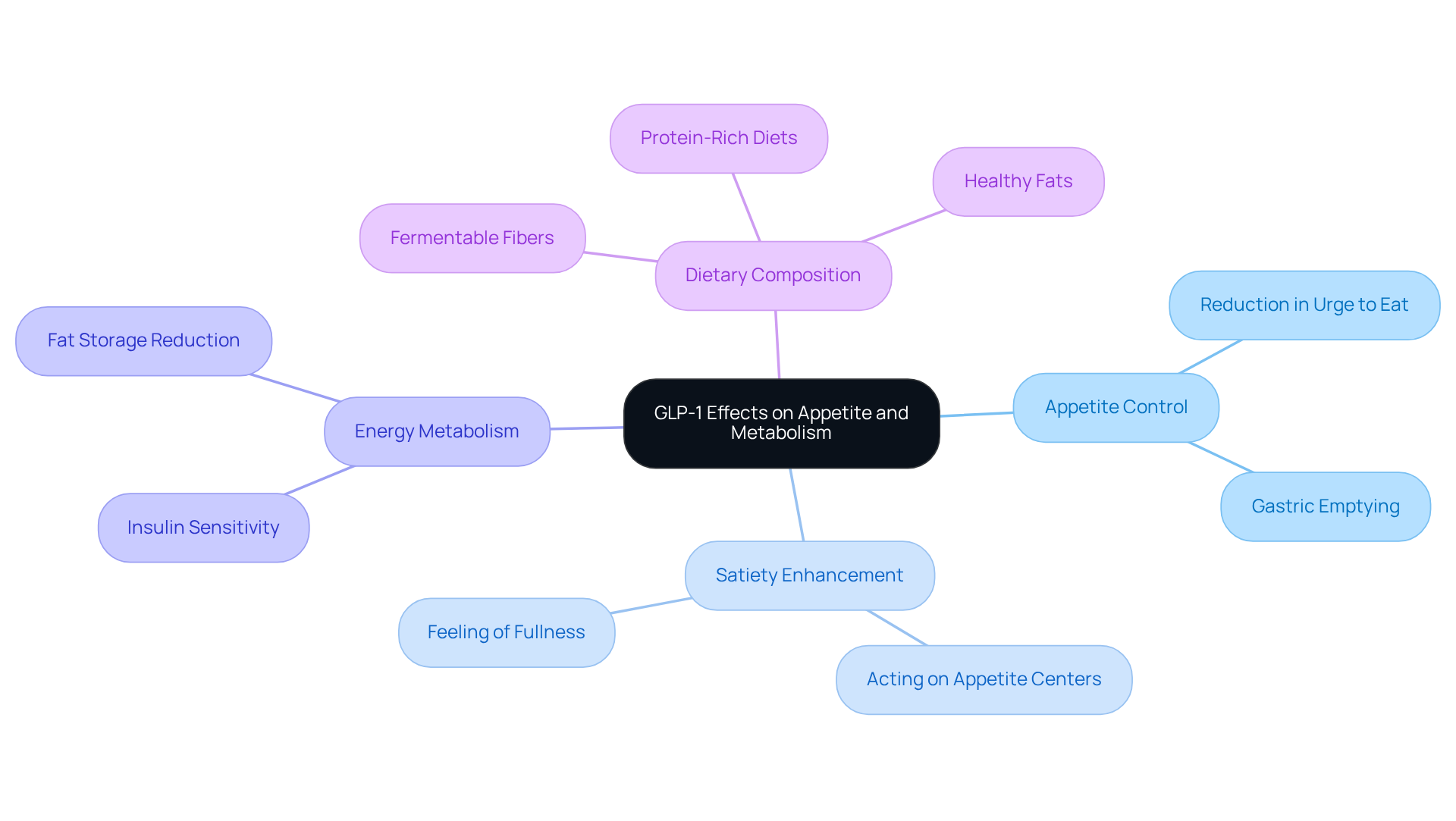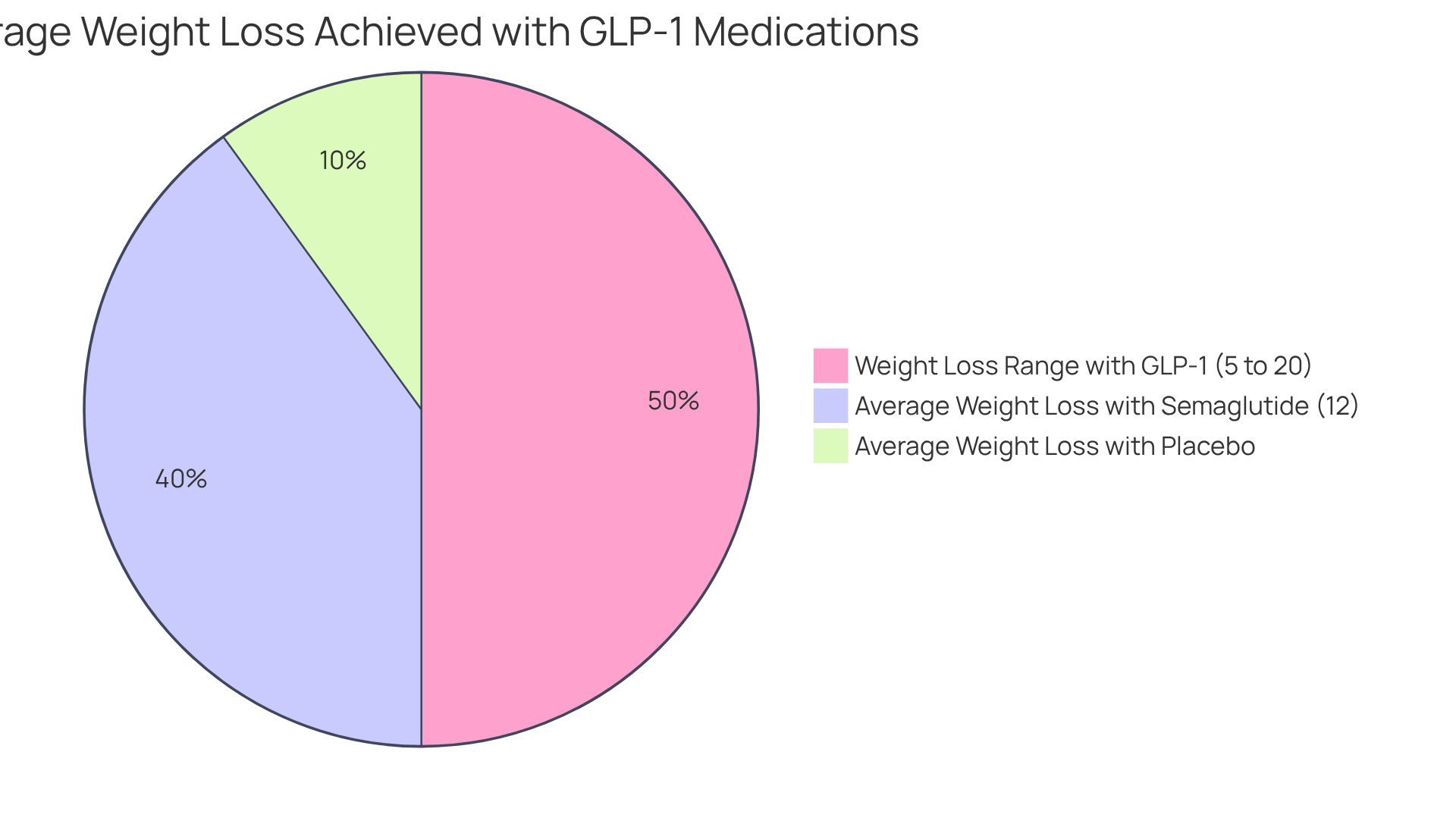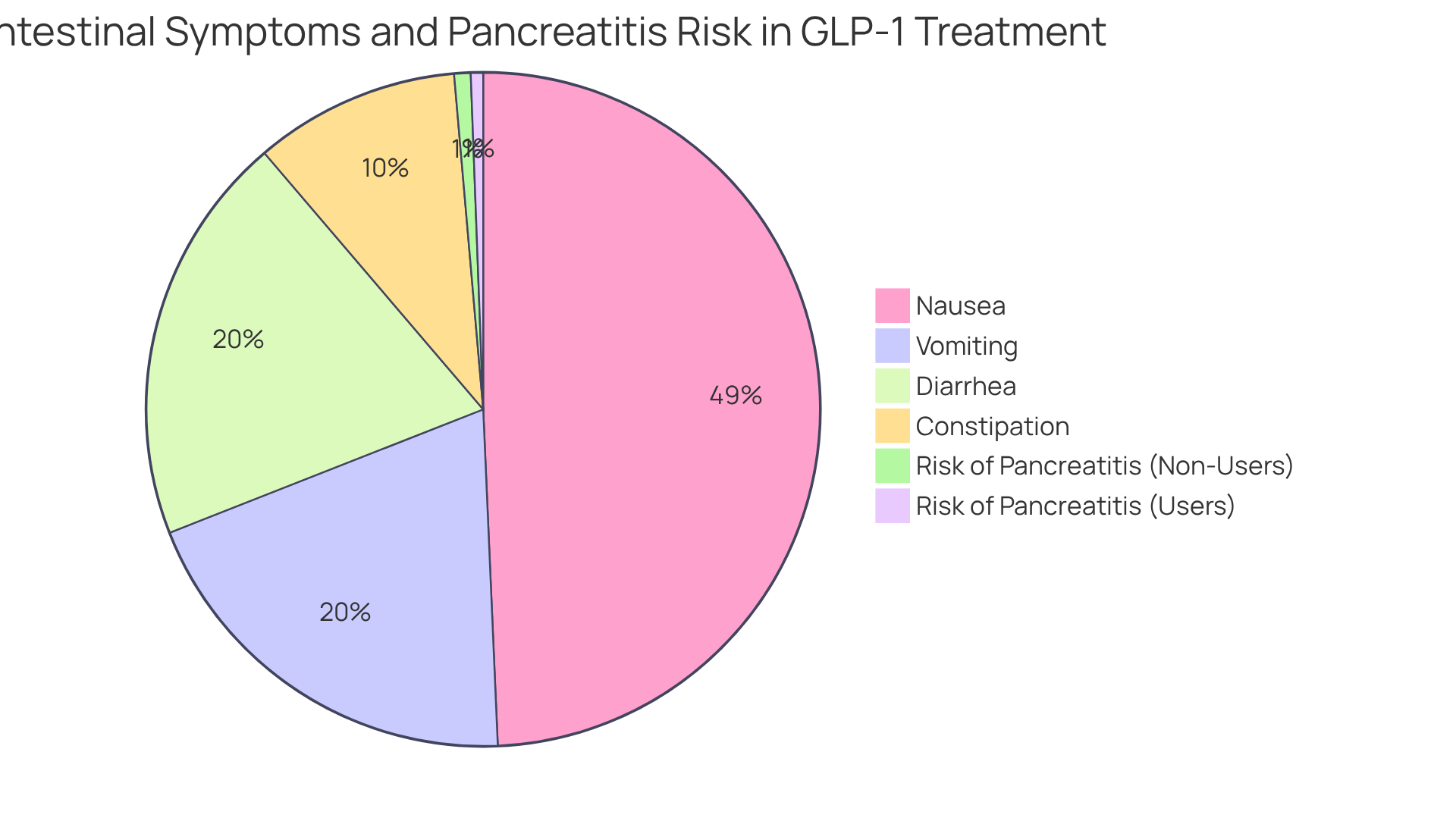Overview
If you’re feeling overwhelmed by your weight loss journey, know that you’re not alone. GLP-1 can be a powerful ally in promoting weight loss. It works by enhancing insulin secretion, slowing gastric emptying, and increasing feelings of fullness, all of which help reduce food intake. Imagine feeling more in control and satisfied with your meals.
Clinical evidence supports the effectiveness of GLP-1 receptor agonists, such as semaglutide, showing significant weight loss in patients using these medications compared to those who are not. This highlights its important role in successful weight management strategies. Together, we can explore how this option might fit into your journey.
As you consider your next steps, remember that support is available. We’re here for you, and with the right tools and guidance, achieving your goals is within reach. You deserve to feel empowered and confident in your choices.
Introduction
Glucagon-like peptide-1 (GLP-1) has emerged as a powerful ally in the journey of weight management, captivating the attention of researchers and health enthusiasts alike. This hormone, released in response to food intake, not only regulates appetite but also enhances insulin secretion and metabolic responses, offering a multifaceted approach to weight loss. However, amidst the excitement surrounding GLP-1 therapies, questions linger about their true effectiveness and the potential challenges users may face. How does this peptide work, and can it truly be the key to unlocking sustainable weight loss?
We understand that navigating the complexities of weight loss can feel overwhelming. It’s important to explore solutions that resonate with your experiences and concerns. GLP-1 offers a promising avenue, but it’s essential to examine how it fits into your unique journey. Together, we can uncover the potential of this peptide and its role in achieving your goals.
Understand the Mechanism of GLP-1 in Weight Loss
Glucagon-like peptide-1, often referred to as a hormone, plays a crucial role in managing glucose metabolism and regulating appetite, leading to the inquiry of how effectively does GLP-1 work. Released by the intestines in response to food intake, this peptide offers various physiological benefits that can help in reducing body mass. To understand how does GLP-1 work, it is important to note that it enhances insulin secretion in a glucose-dependent manner, effectively lowering blood sugar levels. Additionally, it inhibits glucagon release, slows gastric emptying, and promotes feelings of fullness (satiety), which leads to the inquiry of how does GLP-1 work? These combined effects lead to decreased food consumption and, ultimately, weight loss, which raises the question of how does GLP-1 work.
GLP-1 receptor agonists, such as Ozempic® and Wegovy®, mimic the effects of natural hormones, leading to the question of how effectively does GLP-1 work in providing valuable support for individuals striving to manage their body mass by modifying appetite and metabolic responses to food. Research shows that patients taking certain medications can experience significant weight loss, raising the question of how well does GLP-1 work, as individuals using semaglutide lose an average of 33.7 pounds compared to just 5.7 pounds in those not on the medication. This highlights the effectiveness of these treatments in managing body mass, especially when integrated into a personalized health journey like those offered by Minimal, starting at $99.99/month.
Moreover, Compounded Tirzepatide presents a tailored approach to weight loss, enhancing the potential for achieving and maintaining weight loss results. However, it’s essential to recognize that understanding how does GLP-1 work can enhance the effectiveness of these receptor stimulators when used alongside other treatment strategies, including lifestyle and dietary changes. Potential side effects, such as nausea and the possibility of appetite suppression returning after stopping the medication, should also be taken into account. As Emma Beckett wisely states, “Let food be thy medicine,” underscoring the importance of making mindful dietary choices in conjunction with medication for the best outcomes.
Additionally, ongoing research is investigating how does GLP-1 work regarding the safety and effectiveness of receptor stimulators for individuals with Type 1 diabetes, adding to the broader context of these medications. In general, understanding how does GLP-1 work by incorporating receptor agonists into a comprehensive management plan, which includes dietary considerations and the holistic health solutions provided by Minimal, can lead to significant improvements in both body mass and metabolic wellness. Together, we can navigate this journey toward better health and well-being.
Examine the Physiological Effects of GLP-1 on Appetite and Metabolism
This peptide plays a crucial role in weight management, particularly when considering how does GLP-1 work through its diverse physiological effects. Have you ever felt overwhelmed by your weight loss journey? You’re not alone. This peptide enhances satiety by acting on the brain’s appetite centers, which raises the question of how well does GLP-1 work in signaling fullness and reducing the urge to eat. It’s comforting to know that this satiety effect is further supported by the hormone’s ability to slow gastric emptying, prolonging that satisfying feeling of fullness after meals.
Moreover, this peptide positively affects energy metabolism by enhancing insulin sensitivity and reducing fat storage, leading to inquiries about how does GLP-1 work. Studies show that people utilizing receptor agonists experience a significant decrease in appetite along with a rise in energy expenditure. This promotes a successful reduction in body mass, which underscores the importance of understanding how does GLP-1 work in appetite control and metabolic wellness. Together, we can explore how this can be a beneficial tool in obesity treatment.
Recent research also indicates that dietary composition can improve hormone secretion. This suggests that a comprehensive strategy merging medication and nutrition may optimize reductions in body mass. For instance, increased consumption of fermentable fibers has been associated with elevated levels of a certain hormone, further endorsing dietary approaches for managing body mass.
In summary, the incorporation of receptor stimulators into slimming initiatives raises the question of how does GLP-1 work in improving health and attaining lasting outcomes. Remember, we’re here for you, and together, we can achieve your goals for a healthier future.
Review Clinical Evidence Supporting GLP-1 for Weight Loss
Many individuals face challenges in their weight loss journey, and it’s important to know that you’re not alone. Several clinical trials have highlighted the effectiveness of receptor agonists in aiding fat loss, prompting the inquiry into how well does GLP-1 work as a vital component of personalized fat reduction strategies. For instance, a meta-analysis of randomized controlled trials explored how does GLP-1 work in enabling participants using GLP-1 medications to achieve an average weight loss of 5% to 20% over 68 weeks. In a notable study, patients who received semaglutide achieved an average reduction of about 12%, leading to the inquiry of how well does GLP-1 work compared to those on a placebo.
What’s even more encouraging is that real-world evidence supports how does GLP-1 work in practice. Many individuals continue to experience significant weight loss after moving from clinical trials to everyday use. This consistency across diverse populations underscores the promise of these treatments as a cornerstone in obesity management strategies, leading to inquiries about how does GLP-1 work. When integrated into a comprehensive health approach that considers individual patient needs and lifestyle factors, these treatments can truly make a difference.
Together, we can navigate this journey, and with the right support, achieving your goals is within reach. Remember, we’re here for you every step of the way.
Assess Risks and Side Effects of GLP-1 Treatments
While receptor stimulators, like compounded Tirzepatide, are generally well-accepted, it’s important for you to be aware of specific side effects. Many individuals may experience gastrointestinal symptoms such as:
- Nausea
- Vomiting
- Diarrhea
- Constipation
These symptoms can affect up to 50% of users. The good news is that these symptoms often diminish over time as your body adjusts to the medication.
In rare cases, more serious side effects can occur, such as:
- Pancreatitis
- Kidney issues
- Potential thyroid tumors
However, it’s reassuring to know that individuals using receptor agonists have a notably reduced lifetime risk of pancreatitis compared to non-users, with rates of 0.3% versus 0.4%. This information highlights the importance of discussing these risks with your healthcare provider to understand how GLP-1 works and if the treatments are right for you.
At Minimal, we offer personalized options that include comprehensive care through tailored nutrition plans, fitness plans, and regular check-ins. Understanding these risks is vital for making informed decisions about your weight loss strategies and managing expectations regarding treatment outcomes. Many clients begin to notice improvements within just a few weeks of starting their holistic weight loss journey. Remember, together, we can achieve your goals, and we’re here to support you every step of the way.
Conclusion
Exploring GLP-1’s role in weight loss reveals its significant impact on appetite regulation and metabolic processes. By enhancing insulin secretion, promoting satiety, and slowing gastric emptying, GLP-1 serves as a powerful ally for those seeking to manage their weight effectively. Clinical evidence underscores the effectiveness of GLP-1 receptor agonists, such as Ozempic® and Wegovy®, demonstrating substantial weight loss in users compared to those not utilizing these treatments.
Key insights highlight the physiological effects of GLP-1 on appetite and metabolism, emphasizing its potential to enhance weight management strategies. Imagine combining GLP-1 therapies with personalized dietary and lifestyle changes—this combination can lead to remarkable results. Studies show average weight losses of 5% to 20% among participants, illustrating the potential of this approach. However, understanding the potential side effects and risks associated with GLP-1 treatments is essential for informed decision-making in your weight management journey.
Ultimately, the journey toward better health through GLP-1 is not just about medication; it encompasses a holistic approach that includes mindful dietary choices and lifestyle adjustments. By integrating GLP-1 treatments into a comprehensive plan, you can navigate your weight loss journey more effectively. Together, we can make strides toward improved metabolic wellness and overall quality of life. Embracing this multifaceted strategy empowers you to take charge of your health and achieve lasting outcomes in your quest for weight management.
Frequently Asked Questions
What is GLP-1 and what role does it play in weight loss?
GLP-1, or glucagon-like peptide-1, is a hormone that manages glucose metabolism and regulates appetite, contributing to weight loss by enhancing insulin secretion, inhibiting glucagon release, slowing gastric emptying, and promoting feelings of fullness.
How does GLP-1 work to promote weight loss?
GLP-1 works by lowering blood sugar levels, decreasing food consumption, and increasing satiety, which collectively lead to weight loss.
What are GLP-1 receptor agonists and how do they help with weight management?
GLP-1 receptor agonists, such as Ozempic® and Wegovy®, mimic the effects of GLP-1, helping individuals manage their body mass by modifying appetite and metabolic responses to food.
How effective are GLP-1 medications for weight loss?
Research indicates that patients using semaglutide can lose an average of 33.7 pounds, compared to 5.7 pounds in those not on the medication, highlighting their effectiveness in managing body mass.
What is Compounded Tirzepatide and how does it relate to weight loss?
Compounded Tirzepatide is a tailored approach to weight loss that enhances the potential for achieving and maintaining weight loss results, working alongside GLP-1 receptor agonists.
What are some potential side effects of GLP-1 medications?
Potential side effects include nausea and the possibility of appetite suppression returning after discontinuation of the medication.
How can dietary choices impact the effectiveness of GLP-1 treatments?
Making mindful dietary choices in conjunction with GLP-1 medications is important for achieving the best outcomes in weight management.
Is there ongoing research regarding GLP-1 for individuals with Type 1 diabetes?
Yes, ongoing research is investigating the safety and effectiveness of GLP-1 receptor stimulators for individuals with Type 1 diabetes.
How can GLP-1 be incorporated into a comprehensive weight management plan?
Incorporating GLP-1 receptor agonists into a management plan that includes dietary considerations and holistic health solutions can lead to significant improvements in body mass and metabolic wellness.





















